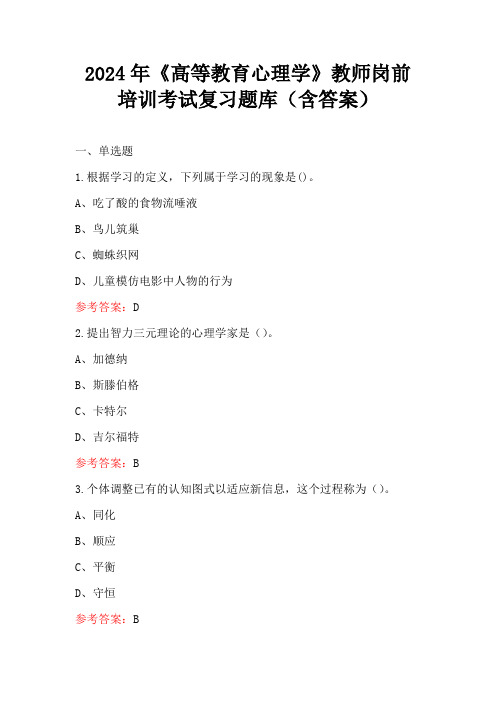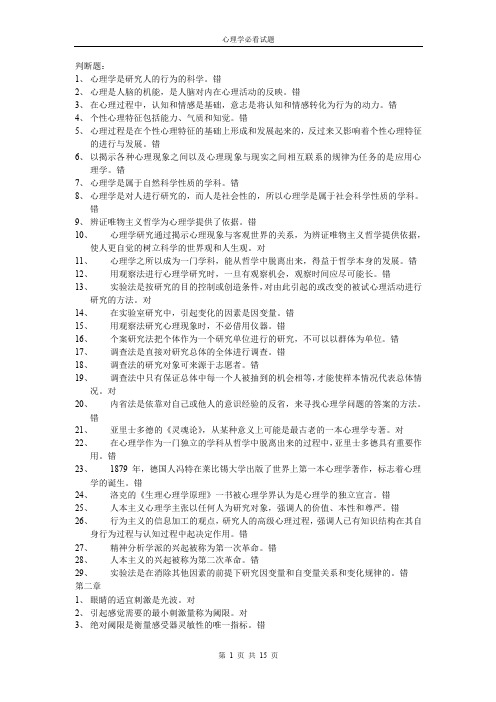教师心理学复习
2024年《高等教育心理学》教师岗前培训考试复习题库(含答案)

2024年《高等教育心理学》教师岗前培训考试复习题库(含答案)一、单选题1.根据学习的定义,下列属于学习的现象是()。
A、吃了酸的食物流唾液B、鸟儿筑巢C、蜘蛛织网D、儿童模仿电影中人物的行为参考答案:D2.提出智力三元理论的心理学家是()。
A、加德纳B、斯滕伯格C、卡特尔D、吉尔福特参考答案:B3.个体调整已有的认知图式以适应新信息,这个过程称为()。
A、同化B、顺应C、平衡D、守恒参考答案:B4.“张三在喝水”中的关系是()。
A、喝B、在C、张三D、水参考答案:A5.用一套预先经过标准化了的问题(量表)施测于某一个体或群体来收集研究资料的方法是()。
A、实验法B、调查法C、测验法D、观察法参考答案:C6.通过计算:1=?1+3=?1+3+5=?1+3+5+7=?并将A、例—规法B、规—例法C、同化法D、分化法参考答案:A7.关于事物及其关系的知识属于()。
A、情境性知识B、陈述性知识C、程序性知识D、策略性知识参考答案:B8.形成各种操作技能不可缺少的关键环节是()。
A、分化B、系统化C、练习D、产生式学习参考答案:C9.小华最近遇到了一些困难,心理辅导老师引导他梳理了错误观念,形成了的认识,解决了问题,小华所接受的这种心理辅导方法是()。
A、行为治疗B、认知治疗C、人本主义疗法D、精神分析参考答案:B10.个体能够摆脱感知和形象的支持,通过逻辑的、假设的和系统的推理来寻求问题的解决,按照皮亚杰的理论,这处于的认知发展阶段是()。
A、感知运动阶段B、前运算阶段C、具体运算阶段D、形式运算阶段参考答案:D11.改变非本质属性、保持本质属性的概念正例的变化,称为()。
A、比较B、变式C、演绎D、分化参考答案:B12.表现在一个人对待现实的态度和行为方式上的比较稳定的心理特征是()。
A、气质B、性格C、能力D、兴趣参考答案:B13.下列属于替代性强化的是()。
A、观察到他人行为受到表扬,增加自己表现这种行为的倾向B、实施行为后给予物质奖励,增加其表现这种行为的倾向C、根据一定标准进行自我评价和自我监督,强化相应行为D、实施行为后给予积极的社会评价,增加其表现这种行为的倾向参考答案:A14.青少年从朋友处获得大量的信息、资源和援助。
教师招聘考试心理学知识点整理

CHAPTER 04
社会心理学
社会心理学的定义与性质
定义
社会心理学是研究个体在社会群体中的心理活动和行为规律 的学科。它主要关注个体在社会环境中的认知、情感、动机 和行为等方面。
性质
社会心理学具有跨学科性,它涉及到心理学、社会学、人类 学等多个领域。同时,社会心理学也具有应用性,它对于解 决现实问题、改善人际关系和提高生活质量具有重要意义。
婴儿期
婴儿期是人生发展的第一个阶段,主要任 务是解决信任和不信任的心理问题,发展 出基本的信任感。
青少年期
青少年期是人生发展的第五个阶段,主要 任务是解决自我同一性和角色混乱的问题 ,发展出自我同一性。
幼儿期
幼儿期是人生发展的第二个阶段,主要任 务是解决自主性和羞怯感的问题,发展出 自主性和自我控制能力。
CHAPTER 02
教育心理学
教育心理学的定义与性质
定义
教育心理学是心理学与教育实践相结 合的产物,是研究教育过程中人的心 理活动规律的科学。
性质
教育心理学是教育学和心理学的交叉 学科,具有应用性和实践性。
教育心理学的主要研究领域
学习心理
研究学习的本质、过程、条件、类型、 策略等,以及不同年龄段学生的学习特
社会认知过程与偏差
社会认知过程
社会认知过程是指个体在社会环境中对他人和社会的认知和理解过程。它包括对 他人的知觉、印象形成、归因和判断等方面。
认知偏差
在社会认知过程中,由于各种原因,人们可能会出现认知偏差。常见的认知偏差 包括首因效应、近因效应、晕轮效应、刻板印象等。这些偏差会影响人们对他人 和社会的正确认知和理解。
促进个性化教学
教育心理学的研究可以帮助教师更好地了解学生的个性特 点和需求,从而进行个性化教学,满足学生的不同需求。
小学教师心理学复习资料

小学教师心理学复习资料在小学教育中,小学教师们的心理素质显得尤为重要。
因为正是教师们的心态和心理状态,影响着对学生的教育和引导。
所以,对于小学教师而言,一份心理学复习资料十分必要。
首先,小学教师应该具备独立自信的心理素质。
如果教师缺乏自信,那么在教学过程中,难免会出现犹豫、迟疑和胆怯的情况,往往让学生感到教师的无能和软弱。
而如果教师具备了独立自信的素质,他们的心态就会很稳定,不会被纷繁的事物所干扰,能够做好教学工作的同时,还能够更加专注于自身的成长之路。
其次,小学教师要有适应性强的心理素质。
随着社会的变化,教育的形态也在不断地发生变化。
因此曾经行之有效的教学方式,有时也会变得不再适用。
如果教师没有适应性强的心理素质,就会陷入固化的教学思维模式,导致教育效果不佳。
只有教师具备了适应性强的心理素质,才能够更好地把握住教育的发展脉搏,更好地应对突发的教育变化。
再次,小学教师还需要拥有耐心的心理素质。
在小学教育过程中,教师需要面对各种各样的学生,有相当一部分学生还需要医生精神上的照顾,有的学生学习成绩专注度低下,还有的学生可能非常调皮捣蛋。
而这些因素都可能给小学教师带来许多不必要的压力。
如果教师没有耐心的心理素质,就会很容易失去耐性,从而误导学生。
教育是一项需要耐心的工作,只有耐心的教师,才能够赢得学生的尊敬和信任。
最后,小学教师需要有进取心的心理素质。
学习是一个不断探索与进取的过程,只有在不断地学习和尝试中,教师才能够更好地开拓教育领域。
如果教师没有进取心的心理素质,就会失去学习的激情和动力,从而限制了教育的自我提高和发展空间。
只有教师拥有了进取心的心理素质,才能够将这种激情和动力传递给学生,让他们也能够在教育事业中取得更好的发展和成长。
在小学教育中,小学教师应该注重培养自己的心理素质,只有这样才能更好地促进教育的发展和进步。
因此,建议小学教师可以购买一份心理学复习资料,掌握相关的心理素质知识和技能,不断探索和拓展自身的教育发展空间。
教师招聘考试 心理学知识点整理

错觉—概念:对事物必然产生的固有倾向的歪曲知觉,是对客观事物不正确的知觉,知觉的特殊情况。 (错误的知觉,不可克服)
(观,思,知,言,想)
1) 要引导学生学会观察,丰富学生的表象储备;
2) 引导学生积极思考,有利于打开想象力的大门;
3) 引导学生努力学习科学文化知识,扩大学生的知识经验以发展学生的空间想象能力;
4) 注意发展学生的语言能力;
5 结合学科教学,有目的地训练学生的想象力;
6 引导学生进行积极幻想。
4.言语和思维
比 较 与 分 类 —比较: 人脑中把各种事物或对象对比,确定异同点和关系。 分类: 思想上按事物异同,区分为不同种类的思维过程。
(2) 根据思维的逻辑性:分析思维、直觉思维(如灵感) (3) 根据思维的指向性:聚合思维(求同思维)、发散思维(求异思维)。 (4) 根据思维创作程度:再造性思维(常规习惯性)、创造性思维(人类思维高级形式) (5)经验思维和理论思维。
概念—定义:人脑对客观事物本质特征的认识。(填) 属性:内涵(本质特征)、外延(范例);一个概念的内涵越丰富,所包括的外延就越小。
影响因素:(客观)刺激物绝对强度、独特性,对象背景差别性、活动 性
(主观)知觉目的、已有体验,动机爱好、情绪 理解性:知识经验为基础,再加工,“外行看热闹,内行看门道” 整体性:根据知识经验,把各部分属性综合,整体把握事物;
学生观察力的培养:(简论) 1)引导学生明确观察目的和人物,是良好观察的重要条件; 2 充分准备、周密计划、具体方法,是引导学生完成观察的重要条件; 3 实际观察中加强对学生的个别指导,针对性地培养学生观察习惯; 4 引导学生记录整理观察结果,写观察报告、日记、作文; 5 引导学生开展讨论、交流并汇报观察成果,提高学生观察能力、培养良好观察品质。
教师心理学复习资料(四川)

教育心理学是研究学校情境中学与教的基本心理学规律的科学。
简言之,就是研究学生如何学习,老师如何帮助学生学习的科学。
教育心理学是心理学的一个分支,属于应用心理学的范围学校教育特指在课堂情景中主要通过上课完成的教育学习目标对学习者通过教学以后将能做什么的一种明确的、具体的表述(也称行为目标)发展是指随着生理年龄的推移,作为经验和内部相互作用的结果而在个体的整个体系内产生的机能构造上的变化过程(发展是不可逆的)学习广义:学习是人及动物在生活中获得个体的行为经验的过程。
狭义:特指人类的学习,在社会生活实践中,以语言为中介,自觉地,积极地,主动掌握社会的和个体的经验的过程强化就是条件刺激和无条件刺激在时间上的反复结合。
相关性归属学习即新知识是已有认知结构中某一观念的扩充、深化或限定,此时可通过相关性同化在新旧观念之间建立起一种相互联系的从属关系总括学习(上位学习)即把认知结构中已有的概括性较低的下位概念或命题归入新获得的上位概念或命题中去,从而使新知识总括已有知识学习迁移是一种学习对另一学习的影响,这种影响可以表现在知识的学习和技能的形成方面,也表现在学习方法和学习态度的相互影响方面共同要素论一种学习之所以能促进另一种学习,是因为两种学习具有完全相同的要素,学习迁移的产生与共同要素关系密切,且大致成比例。
(桑代克)。
概括化理论只要一个人对他的经验进行了概括,则就可以完成从一个情境到另一个情境的迁移。
(贾德)记忆恢复即学习后间隔一定时间测得的保持量比学习后立即测得的保持还高的现象理解是个体逐步认识事物的种种联系、关系,直至认识其本质、规律的一种思维活动技能是通过练习而自动化了的动作方式或智力的活动方式高原现象在技能形成过程中,一般在练习的中期出现进步的暂时停滞现象态度人们对事物爱憎、趋避的心理及行为倾向。
态度决定人的行为方式。
(包括信念、情感和行为倾向)学习动机就是激励学生进行学习活动的心理因素。
一切活动都产生于需要注意状态是指学生心理活动对学习对象的指向和集中状态禀赋优异童指智力测验获得智商140以上或在特殊性向测验中有突出表现者,或在创造能力测验得分超群者教学设计:是一种实施教学系统方法的具体的可操作程序教学策略是实现教学目标的方式,它包括四个具体方面:课的划分,教学顺序的设计,教学活动设计及教学组织形式的确定测量是用数学方式对人的行为的描述测验:通过一系列的科学程序对学生某一方面的学习行为进行测量评定:根据一定的标准对学生的学习行为进行估价的过程。
教师资格证心理学复习

个性的定义
01
个性是指一个人在其生活、实践活动中经常表现出来的、比较
稳定的、带有一定倾向性的个体心理特征的总和。
个性的结构
02
个性倾向性(需要、动机、兴趣、理想、信念、世界观等)和
个性心理特征(能力、气质、性格等)。
个性的特征
03
独特性、稳定性、整体性、社会性。
个性差异与教育
个性差异的表现
个性差异主要表现在能力、气质和性格三个方面。
个性倾向性与教育
需要与教育
需要是个体对客观事物的需求在头脑中的反映,是个性积极性的源泉。教师可以通过创设问题情境、提供榜样、给予 鼓励等方式来激发学生的需要。
动机与教育
动机是推动人进行活动的内部动力,是个体行为的直接原因。教师可以通过明确学习目标、提供成功机会、及时反馈 等方式来激发学生的动机。
兴趣与教育
01
认知素质
包括教师的知识水平、认知能力和思维方式。教师应具备广博的知识背
景,良好的观察力、注意力和记忆力,以及灵活的思维方式。
02 03
情感素质
教师的情感素质主要体现在对学生的热爱、对教育事业的忠诚和对工作 的热情等方面。稳定的情绪、良好的情感表达能力和情感调控能力是教 师情感素质的重要组成部分。
心理学的主要流派与理论
构造主义心理学
主张研究意识的结构和构 造,采用内省法进行研究。
行为主义心理学
主张研究可观察的行为, 认为环境是影响行为的重 要因素。
机能主义心理学
强调研究心理在适应环境 中的机能作用,重视心理 学的实际应用。
心理学的主要流派与理论
格式塔心理学
强调整体不等于部分之和,整体先于 部分而存在,并且制约着部分的性质
中高级教师职称考试:心理学考试复习材料

判断题:1、心理学是研究人的行为的科学。
错2、心理是人脑的机能,是人脑对内在心理活动的反映。
错3、在心理过程中,认知和情感是基础,意志是将认知和情感转化为行为的动力。
错4、个性心理特征包括能力、气质和知觉。
错5、心理过程是在个性心理特征的基础上形成和发展起来的,反过来又影响着个性心理特征的进行与发展。
错6、以揭示各种心理现象之间以及心理现象与现实之间相互联系的规律为任务的是应用心理学。
错7、心理学是属于自然科学性质的学科。
错8、心理学是对人进行研究的,而人是社会性的,所以心理学是属于社会科学性质的学科。
错9、辨证唯物主义哲学为心理学提供了依据。
错10、心理学研究通过揭示心理现象与客观世界的关系,为辨证唯物主义哲学提供依据,使人更自觉的树立科学的世界观和人生观。
对11、心理学之所以成为一门学科,能从哲学中脱离出来,得益于哲学本身的发展。
错12、用观察法进行心理学研究时,一旦有观察机会,观察时间应尽可能长。
错13、实验法是按研究的目的控制或创造条件,对由此引起的或改变的被试心理活动进行研究的方法。
对14、在实验室研究中,引起变化的因素是因变量。
错15、用观察法研究心理现象时,不必借用仪器。
错16、个案研究法把个体作为一个研究单位进行的研究,不可以以群体为单位。
错17、调查法是直接对研究总体的全体进行调查。
错18、调查法的研究对象可来源于志愿者。
错19、调查法中只有保证总体中每一个人被抽到的机会相等,才能使样本情况代表总体情况。
对20、内省法是依靠对自己或他人的意识经验的反省,来寻找心理学问题的答案的方法。
错21、亚里士多德的《灵魂论》,从某种意义上可能是最古老的一本心理学专著。
对22、在心理学作为一门独立的学科从哲学中脱离出来的过程中,亚里士多德具有重要作用。
错23、1879年,德国人冯特在莱比锡大学出版了世界上第一本心理学著作,标志着心理学的诞生。
错24、洛克的《生理心理学原理》一书被心理学界认为是心理学的独立宣言。
教育心理学复习资料(整理版)

第一章绪论第一节学校教育心理学的对象、范围和意义一、学校教育心理学研究的对象学校教育心理学是研究学校情境中学与教的基本心理学规律的科学。
简言之,就是研究学生如何学习,教师如何帮助学生学习的科学。
属于应用心理学的范围。
理解学校教育心理学的对象要注意四点:1.学校教育心理学是一门科学的学科,它要遵循科学的全部规律,具备科学学科应具备的要求。
2.学校教育心理学并不研究所有学与教的问题,主要研究学校情境中的学与教;3。
学校教育心理学研究的学与教包括知识、技能的学与教及其伴随这一过程的有关能力的发展,也涉及学生的思想品德、行为习惯和情感态度的学习。
4。
学校教育心理学以学生学习过程的研究为核心,研究序列是学与教而不是教与学。
二、学校教育心理学的研究范围学校教育心理学的研究范围包括:1.对学校教育现象的心理学认识(如从心理学角度对学校、教学、课、学生及教师的认识)2.学习的基本理论(揭示学习的实质和学习过程);3。
各种类型的学习;4.学习的迁移、保持和遗忘;5。
影响学习的主要心理因素(如学习的动机和兴趣、感知和注意状态、学生处我意识、学生的个别差异);6。
学习过程及其结果的测量和评定等。
总之,学校教育心理学关注的焦点是学校中尤其是课堂上所发生的学习事件。
三、学校教育心理学的意义1.增加对学校教育过程和学生学习过程的理解;2.学校教育心理学知识是所有教师的专业基础;3.有助于科学的总结教育教学经验;4.提供了学校教育、教学改革和研究的理论和方法基础。
第二节历史发展和现状一、短暂的历史教育心理学成为独立学科是从1903年美·桑代克《教育心理学》开始,也有人认为19世纪末美国威廉·詹姆士的《对教师的对话》是开始。
二、发展阶段1。
初创时期:(1903年--20世纪20年代)桑代克→行为主义心理学→格式塔心理学→儿童心理学。
2.过渡时期:(20世纪30年代到50年代)体系庞杂无真正突破。
3。
发展时期:(20世纪50年代到80年代)(主要在美苏)代表人物如下:A 布卢姆:1956《教育目标分类》,1976《人类的特征与学习》提出“掌握学习”的理论.B 布鲁纳:1960《教育过程》提出的认知发展学习理论影响很大。
- 1、下载文档前请自行甄别文档内容的完整性,平台不提供额外的编辑、内容补充、找答案等附加服务。
- 2、"仅部分预览"的文档,不可在线预览部分如存在完整性等问题,可反馈申请退款(可完整预览的文档不适用该条件!)。
- 3、如文档侵犯您的权益,请联系客服反馈,我们会尽快为您处理(人工客服工作时间:9:00-18:30)。
1. awhat makes a good teacher?①Attitude warmth humor the ability to care about people self-discipline, enthusiasm, contagious speaking ability.②Knowing the subject matters.③Mastering the teaching skills. Good teachers know their subject matter and have mastered pedagogical skills. they accomplish all the tasks involved in effective instruction with warmth, enthusiasm, and caring. they combine research and common sense.2. components of good teaching?①Decision making: knowledge of subject and teaching resources②Self-knowledge and self-regulation: knowledge of students and their learning ③Reflection: critical thinking and problem-solving skill ④Application of education research: teaching and communication skill3. principle and laws and theory(the goal of research ineducationalA principle explains the relationship between factors, such as the effects of alternative grading systems on student motivation. Laws are simply principles that have been thoroughly tested and found to apply in a wide variety of situations. A theory is a set of related principles and laws that explains a broad aspect of learning behavior, or another area of interest without theories the facts and principles that are discovered would be like disorganized speaks on a canvas. Theories tie together these facts principles to give us the big picture. However the same facts theorists and principles may be interpreted in different ways by different theorists.4.how to be an intelligent consumer of educational psychology researchBe a consumer of relevant research.//be an intentional teacher.//share your experiences.4. what research methods are used in educational psychology?Experiments.//correlational studies.//descriptive research.//action research4. what are some view of human development?Jean pia get’s theory of cognitive and moral development. //Lev vygotsky’s theory of cognitive development. //Erik erikson’s theory of personal and social development.//Lawrence kohlberg’s theories of moral development5. piaget’s stages of cognitive development sensorimotor(0-2years) preoperational(2-7) concrete operational(7-11) formal operational(11-adulthood)6. educational implications of piaget’s theory?①A focus on the process of children’s thinking, not just its products.② Recognition if the crucial role if chi ldren’s self-initiated active involvement in learning activities. ③A deemphasis on practices aimed at making children adult like in their thinking.④Acceptance of individual differences in developmental progress.7. vygotsky’s work is based on two key ideas?First , he proposed that intellectual development can be understood only in terms if the historical and cultural contexts children experience. Second he believed that development depends on the sign systems that individuals grow up with the symbols that culture create to help people think, communicate, and solve problems for example, a culture’s language, writing system, or counting system.8. erikson’s stages of personal and socialdevelopment?trust vs mistrust (0-18) autonomy vs doubt (18-3) initiative vs guilt (3-6) industry vs inferiority (6-12) identity vs role confusion(12-18) intimacy vs isolation(young adulthood) generativity vs self-absorption(middle ad-) integrity vs despair(late ad-)9. piaget’s stages of moral development? Heteronomous morality autonomous marality10. kohlberg’s stages of moral reasoning 三水平六阶段三水平:preconventional level conventional level postconventional level六阶段:s1: punishment and obedience orientation s2:instrumental relativist orientation s3:”good boy-good girl”orientation s4:”law and order”orientation s5:social contract orientation s6:universal ethical principle orientation11. how do children develop during the preschoolrears?Cognitive development physical developmentsocioemotional development12. what kinds of early childhood education programsexist?①Day-care programs.②Preschools.③Compensatory preschool programs.④Early-intervention.⑤Kindergartenprograms.⑥Developmentally appropriate practice13. helping children develop social skills?Reinforcing appropriate social behavior.//Modeling.//Coaching 14. jams marcia’s four identity statuses? Foreclosure.// Identity diffusion.// Moratorium. //Identity achievement 15. problems of adolescence?Emotional disorders. Bullying. Dropping out. Drug and alcohol abuse. Delinquency. Risk of pregnancy. Risk of aids16. the individual component of culture?Social class/nationality/race/ethnic group/abilities and disabilities/religion/geographic region/gender17. key dimensions of multicultural education①knowledge construction:refeir to teachers helping children understand how knowledge is cerated and how it is influenced by the racial of individuals and groups②equity pedagogy: refer to the use of teaching techniques that facilitate the academic success of student from different ethnic. ③an empowering school culture: one in which school organization and practices are conducive to the academic and emotional growth of all students.④prejudice reduction: is a critical goal of multicultural education ⑤content integration:is teacher’s use of examples,data,and information from a variety of cultures.18. the eight intelligences?Logical mathematical/linguistic.musical./naturalist/spatial/bodily kinesthetic/interpersonal/ intrapersonal19. what are some principles of behavioral learning? The role of consequences/ reinforcers/ pinishers/ immediacy of consequences/ shaping/ extinction/ schedules of reinforcement/ maintenance/ the role of antecedents论述1. Socioemotional developmentA young child’s social life evolves in relatively predictable ways. The social network grows from an intimate relationship with parents or other guardians to include other family members, nonrelated adults, and peers. ①Peer relationships. During the preschool years, peers begin to play an increasingly important role in children’s social and cognitiv e development. Peer relationships help young children to overcome the egocentrism that piaget described as being characteristic of preoperational thinking.②prosocial behavior. Prosocial behaviors are voluntary actions toward others such as caring, sharing,comforting,and cooperation. Research on the roots of prosocial behavior has contributed to our knowledge of children’s moral as well as social development.③Play. play is important for children because it exercises their linguistic, cognitive and social skills and contributes to their general personality development. children use their minds when playing, because they are thinking and acting as if they were another person.2. promoting the development of self-esteemGrowing importance of peers: the influenc e if the child’s family, which was the major force during the early childhood years, continuws in importance as parents provide role in terms of attitudes and behaviors. //Friendship in middle childhood: friendship is the central social relationship between peers during childhood, and it undergoes a series of changes before adulthood. Friends are also cognitive resources when they teach or model specific intellectual skill.// Peer acceptance: one of the most understood and perhaps important aspects of peer relations in middle childhood is peer acceptance, or status within the peer group. Many characteristics seem to be related to peer acceptance, including physical attractiveness and cognitive abilities.2. how do students differ in intelligence and learning styles? S tudents differ in their ability to deal with abstractions, to solve problems, and to learn. They also differ in any number of specific intelligences, so accurate estimations of intelligence should probably rely on broader performances than traditional IQ tests allow. Therefore teachers should not base their expectations of students on IQ test scores. S tudents differ in their prior learning and in their cognitive learning styles. Field-dependent people tend to see patterns as a whole and do better with people and social relationships. Individual preferences in learning environments and conditions also affect student achievement.。
